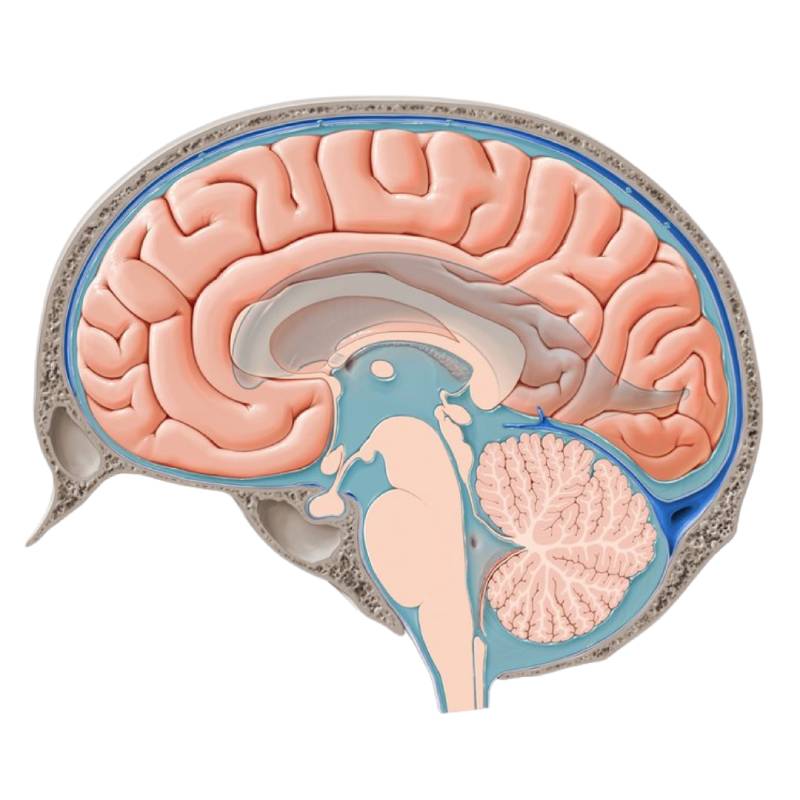Unlocking the Power of Cerebrospinal Fluid (CSF) for Brain Health
Written by Tristan Goulah, Osteopathic Manual Therapist and GYROTONIC® Trainer
How Cerebrospinal Fluid (CSF) Supports Brain Health—and What Happens When It Doesn’t Flow Right
When it comes to brain health, we often focus on the mind itself, but there’s another crucial player we shouldn’t overlook: cerebrospinal fluid (CSF). This clear, watery substance surrounds and protects the brain and spinal cord, supporting everything from the brain’s buoyancy to its ability to clear waste. In fact, CSF is essential to keeping your brain functioning at its best.
But what happens when CSF flow is disrupted? In this blog, we’ll break down how CSF works, what can go wrong when it isn’t flowing properly, and how a movement-based approach like the GYROTONIC® method can help restore balance and improve brain health.

What Does Cerebrospinal Fluid (CSF) Do?
CSF is not just “brain juice”—it’s doing some pretty important work behind the scenes to keep your brain and spinal cord healthy and functioning. Here’s a breakdown of its key roles:
- Buoyancy: The human brain weighs about 1400–1500 grams, but thanks to CSF, it’s effectively “floating” and only feels like it weighs about 25–50 grams. This buoyancy helps prevent the brain from pressing down on itself under its own weight, allowing it to function more efficiently.
- Protection: CSF acts as a natural shock absorber. When you’re jolted or hit, CSF cushions the brain, protecting it from mechanical injury that could otherwise cause harm.
- Preventing Brain Ischemia: CSF helps manage intracranial pressure, creating just the right balance to ensure that blood flow to the brain is maintained. When CSF levels are off, it can impact blood supply, depriving brain tissue of the oxygen and nutrients it needs.
- Regulation: CSF plays a role in maintaining homeostasis in the brain, regulating the distribution of vital substances like electrolytes and neuroendocrine factors. Any imbalance can affect your brain’s overall function.
- Waste Clearance: CSF helps clear out metabolic waste products from the brain. It’s a key part of the brain’s lymphatic system, known as the glymphatic system. If this system doesn’t work properly, waste can accumulate, contributing to neurological diseases.
What Happens When CSF Flow Gets Disrupted?
When CSF flow is compromised, it can have serious effects on brain and spinal cord health. Here’s what can go wrong:
- Loss of Buoyancy: If CSF levels drop, the brain becomes “heavier,” and the increased pressure can cut off blood flow to certain parts of the brain. This can result in neuronal damage, especially in the lower regions of the brain.
- Less Protection: A decrease in CSF volume means less cushioning for the brain, making it more vulnerable to injury. Without that shock absorption, even minor impacts could cause damage.
- Brain Ischemia: Abnormal changes in CSF volume—whether too much or too little—can disrupt blood flow, leading to ischemia (a lack of oxygen and nutrients in brain tissue), which can cause long-term damage.
- Imbalance in Regulation: If CSF flow is off, the brain’s ability to distribute important substances between cells is impaired. For example, high levels of glycine (an amino acid) can interfere with temperature and blood pressure regulation, while changes in CSF pH can cause dizziness or fainting.
- Waste Build-up: Without proper CSF circulation, waste products like amyloid plaques (linked to Alzheimer’s disease) can build up around the brain and spinal cord, leading to neurological problems.
How CSF Moves (And What Affects It)
CSF is created in the choroid plexus, a network of blood vessels deep in the brain. It flows through the ventricles and into the aqueduct, exiting through small openings (called apertures) into the subarachnoid space, which is the area between the brain and spinal cord. From there, it circulates around the brain and spinal cord, nourishing and protecting the brain’s tissues.
The flow of CSF is influenced by body movement and breathing. When we move or breathe deeply, pressure changes in the body help “pump” CSF through the brain and spinal cord. This process helps clear waste and ensures the brain gets the nutrients it needs. When movement is restricted—whether from poor posture, lack of physical activity, or breathing issues—CSF circulation can stagnate, affecting brain function.
How the GYROTONIC® Method Can Help
At PT’MOVEMENT, we’ve seen firsthand how the GYROTONIC® method can help improve CSF flow and, as a result, support better brain health. The GYROTONIC® method is a movement practice that targets the spine and nervous system to restore balance and function. Over the course of 8–12 weeks, the method works in two key ways:

Restoring Space and Alignment: The first priority is to address any postural imbalances that may be compressing the spaces where CSF flows. By improving spinal alignment, we create more room for CSF to circulate freely, reducing pressure on the brain and spinal cord.
Increasing CSF Flow: The second step is to use rhythmic, fluid movements along with diaphragmatic breathing to help “pump” CSF through the brain and spinal cord. The gentle pressure changes created by breathing help encourage the flow of CSF, while the movements stimulate circulation, clearing waste and improving nourishment to the nerve tissues.
As you continue through the program, stagnant waste around the brain and spinal cord begins to move, and nourishing blood starts flowing more freely. Common symptoms such as headaches, dizziness, brain fog, fatigue, and irritability often improve as the CSF flow is restored to normal.
What to Expect from Improved CSF Flow
When CSF circulation improves, you may experience a range of benefits, including:
- Reduced headaches and dizziness
- Better focus and mental clarity
- Improved sleep quality
- Less nausea and fatigue
- Increased energy and motivation
- Reduced brain fog and irritability
Conclusion: Keep Your Brain Healthy with CSF Support
Cerebrospinal fluid plays a vital role in brain health—helping the brain stay buoyant, protected, and free of waste. But when CSF flow is disrupted, it can affect everything from cognitive function to physical health.
The GYROTONIC® method offers a unique, effective way to restore and optimize CSF flow, improving overall brain health and helping to reduce symptoms like headaches, dizziness, and fatigue. If you’re ready to support your brain and take your health to the next level, contact us today to learn more about how the GYROTONIC® method can help.
We’ve got a Nervous System Reset GYROTONIC® Training Package to focus on these very things!
Learn more.

Let’s move your brain to a better place!
Blog Stories






